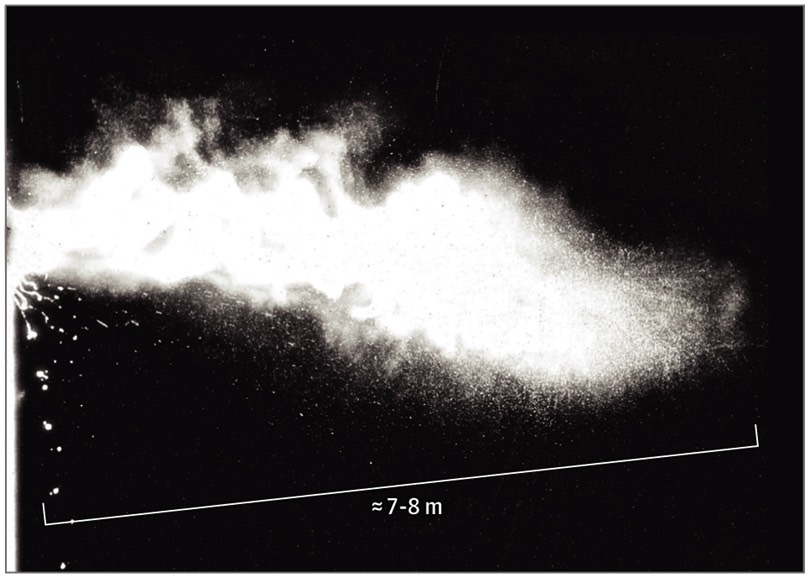Terrifying Video Shows How Far Coronavirus Can Travel In A Sneeze
- A new video reveals how far a sneeze can spray coronavirus droplets if there are no barriers to obstruct their path.
- Virus-carrying droplets of various sizes can travel up to 27 feet, or well beyond the recommended 6-foot social distancing recommendations.
- Healthcare personnel treating COVID-19 patients might require personal protective equipment even while they're farther than 6 feet away from infected people.
- Visit BGR's homepage for more stories.
The spread of the novel coronavirus can be slowed significantly by adhering to strict social distancing measures until local outbreaks are contained, coupled with improved hygiene. But there's no way to completely isolate yourself from the world. People still have to go out for food and supplies, and essential services employ a workforce of millions of people who also have to go out every day. That's where the risk of transmission increases, especially in crowded places. A sneeze or a cough for someone infected is enough to pass on the disease to other people. That's why the use of face masks or covers is encouraged. Also, people are advised to sneeze and cough in their elbow or a tissue that they can dispose of.
Official guidelines say you should be at least 3 feet away from other people while some advise a distance of 6 feet as safe, the idea being that droplets might not be able to travel that far in the air. But more and more studies indicate that the virus might be able to survive in the air for longer than believed and travel over longer distances. Now, a new video shows that droplets ejected via a sneeze can travel up to 27 feet if there's no barrier to stop them.
Posted in the Journal of the American Medical Association (JAMA), the slow-motion video shows that a sneeze cloud that can contain pathogens like the novel coronavirus can travel well beyond the 3 to 6-foot guidelines. Here's a screenshot from the clip:

In the past few weeks, we saw similar simulations that tried to explain what happens when a person coughs or sneezes in a closed space like a grocery store or out in the open. A different video also showed that micro-droplets won't necessarily settle on the ground or other objects, and they can be ejected while someone talks as opposed to solely from a cough or sneeze. The coronavirus in aerosols can then linger in the air for hours and can potentially infect others. The CDC shared a study from China that showed the coronavirus was found up to 13 feet away from a patient in a hospital where airflow and cleanliness are controlled.
Massachusetts Institute of Technology's Lydia Bourouiba explains in the JAMA article with the current guidelines use a model of respiratory disease transmission developed in the 1930s that might be oversimplified. As a result, they might not apply to the current reality, taking into account what happens when a person coughs or sneezes. Bourouiba authored studies a few years ago that looked at the mechanics of sneezing in connection with respiratory diseases.
It's not just the speed and trajectory of ejected particles that matters, but also the movement of the warm gas clouds they're part of that can increase the viability of virus present in droplets:
Recent work has demonstrated that exhalations, sneezes, and coughs not only consist of mucosalivary droplets following short-range semiballistic emission trajectories but, importantly, are primarily made of a multiphase turbulent gas (a puff) cloud that entrains ambient air and traps and carries within it clusters of droplets with a continuum of droplet sizes. The locally moist and warm atmosphere within the turbulent gas cloud allows the contained droplets to evade evaporation for much longer than occurs with isolated droplets. Under these conditions, the lifetime of a droplet could be considerably extended by a factor of up to 1000, from a fraction of a second to minutes.[...]
Given various combinations of an individual patient's physiology and environmental conditions, such as humidity and temperature, the gas cloud and its payload of pathogen-bearing droplets of all sizes can travel 23 to 27 feet (7-8 m).
Bourouiba says these findings suggest that proper personal protective equipment is required primarily for healthcare workers who treat COVID-19 patients, even if they're farther than 6 feet away from patients. Face mask technology should also be studied more to see how it affects high-momentum gas cloud emissions to better understand what degree of protection masks can offer and whether they require design changes.
Studies looking at how coronavirus droplets can spread in the air are yet to explain what amount of viral load in aerosols might be contagious.
